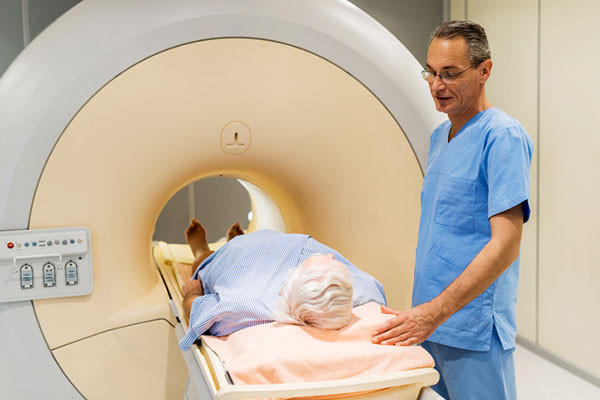
When it comes to limiting side effects from radiation therapy, the name of the game is precision. Doctors want to treat the cancer while avoiding healthy tissues, and fortunately technological advances are making that increasingly possible.
One newer technique called stereotactic body radiotherapy (SBRT) can focus precisely targeted beams of high-dose radiation on a tumor from almost any direction.
The entire course of therapy requires only five individual treatments over two weeks, making SBRT more convenient than earlier low-dose methods that require more visits to the clinic. The treatment relies on specialized types of medical imaging scans that allow doctors to visualize where cancer exists in the body.
Advances in technology
Recently, doctors have begun to integrate SBRT with imaging scans that can visualize a tumor's movements in real time. Simple acts such as breathing, swallowing, or digesting food can shift a tumor's position. But this new technique — which is called magnetic resonance–guided daily adaptive SBRT, or MRg-A-SBRT for short — continually adjusts for those motions, so that doctors can focus more precisely on their targets.
Now, a new study helps to confirm that MRg-A-SBRT has fewer side effects than a related method called CT-SBRT, which uses computed tomography for imaging.
According to the study's lead author, Dr. Jonathan Leeman, a radiation oncologist at Harvard-affiliated Brigham and Women's Hospital in Boston, MRg-A-SBRT offers several advantages over CT-SBRT: one is that doctors using it can adjust treatment plans to account for a tumor's daily motions (this is called adaptive planning). The technology collects multiple MRI images per second during a radiation procedure, thus ensuring accurate real-time targeting. And finally, MRI visualizes the prostate with better resolution.
Analysis of studies
During the new study, Dr. Leeman and his colleagues searched the medical literature for every published clinical trial so far evaluating SBRT for prostate cancer, either with MRI or CT guidance. (This type of study is called a systematic review.)
The team ultimately identified 29 clinical trials that monitored outcomes for a total of over 2,500 patients. Short-term data on side effects was collected for up to three months on average after the procedures were completed.
Leeman's team used statistical methods to pool results from the studies into combined datasets. They found that the MR-SBRT-treated patients had fewer side effects. Specifically, 5% to 33% of men treated with MR-SBRT had genitourinary side effects, compared to between 9% and 47% of men who had the CT-guided treatments. Similarly, the risk of gastrointestinal side effects in the MR-SBRT-treated men ranged from 0% to 8%, compared to between 2% and 23% among men whose treatments were guided by CT.
Conclusions and comments
The authors concluded that "technical advances in precision radiotherapy delivery afforded by MRg-A-SBRT translate to measurable clinical benefit" (i.e., better tolerated treatments). But precisely why the treatments were better tolerated remains unclear. Is it because MR-scanning has better resolution? Did adaptive planning (and real-time targeting) account for the lower risk of side effects, or can that be attributed to some combination of all these factors? Dr. Leeman says that adaptive planning is "likely the main differentiator," but he adds that further studies are needed to confirm where the benefits come from.
To place this important work in perspective, we reached out to the authors of the new paper, as well as Dr. Anthony Zietman and Dr. Nima Aghdam, two Harvard-affiliated radiation oncologists who are also on the editorial board of the Harvard Medical School Annual Report on Prostate Diseases. All these experts feel this new technology has very promising potential.
But both groups cautioned that as with all newly developed innovations, results from additional studies — including clinical trials that are currentlyongoing — will be needed before more widespread uptake of the technology is warranted. Dr. Marc B. Garnick, the Gorman Brothers Professor of Medicine at Harvard Medical School and Beth Israel Deaconess Medical Center, says he "agrees with this conservative, yet optimistic assessment."
About the Author

Charlie Schmidt, Editor, Harvard Medical School Annual Report on Prostate Diseases
Charlie Schmidt is an award-winning freelance science writer based in Portland, Maine. In addition to writing for Harvard Health Publishing, Charlie has written for Science magazine, the Journal of the National Cancer Institute, Environmental Health Perspectives, … See Full Bio View all posts by Charlie Schmidt
About the Reviewer

Marc B. Garnick, MD, Editor in Chief, Harvard Medical School Annual Report on Prostate Diseases; Editorial Advisory Board Member, Harvard Health Publishing
Dr. Marc B. Garnick is an internationally renowned expert in medical oncology and urologic cancer. A clinical professor of medicine at Harvard Medical School, he also maintains an active clinical practice at Beth Israel Deaconess Medical … See Full Bio View all posts by Marc B. Garnick, MD
